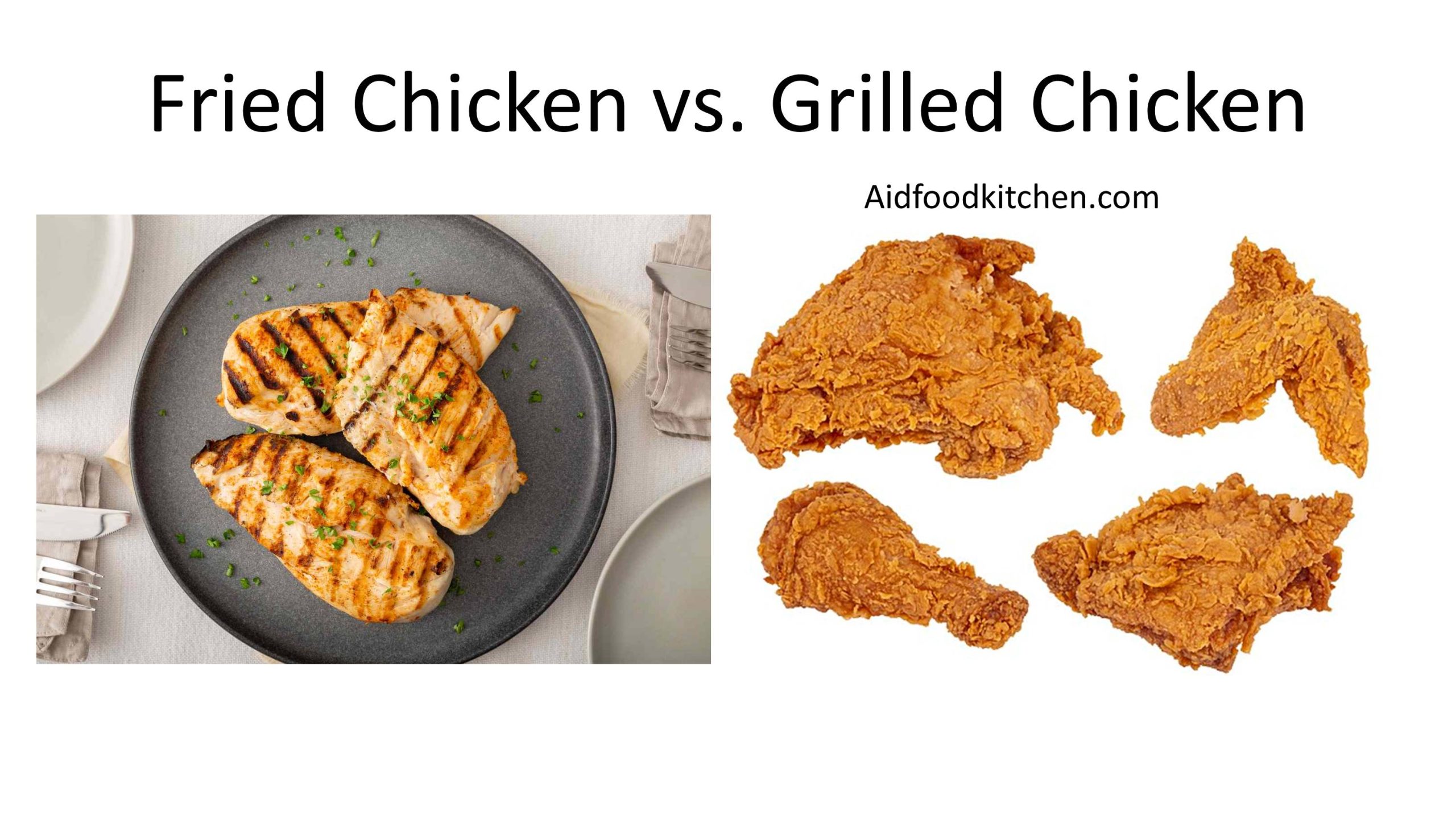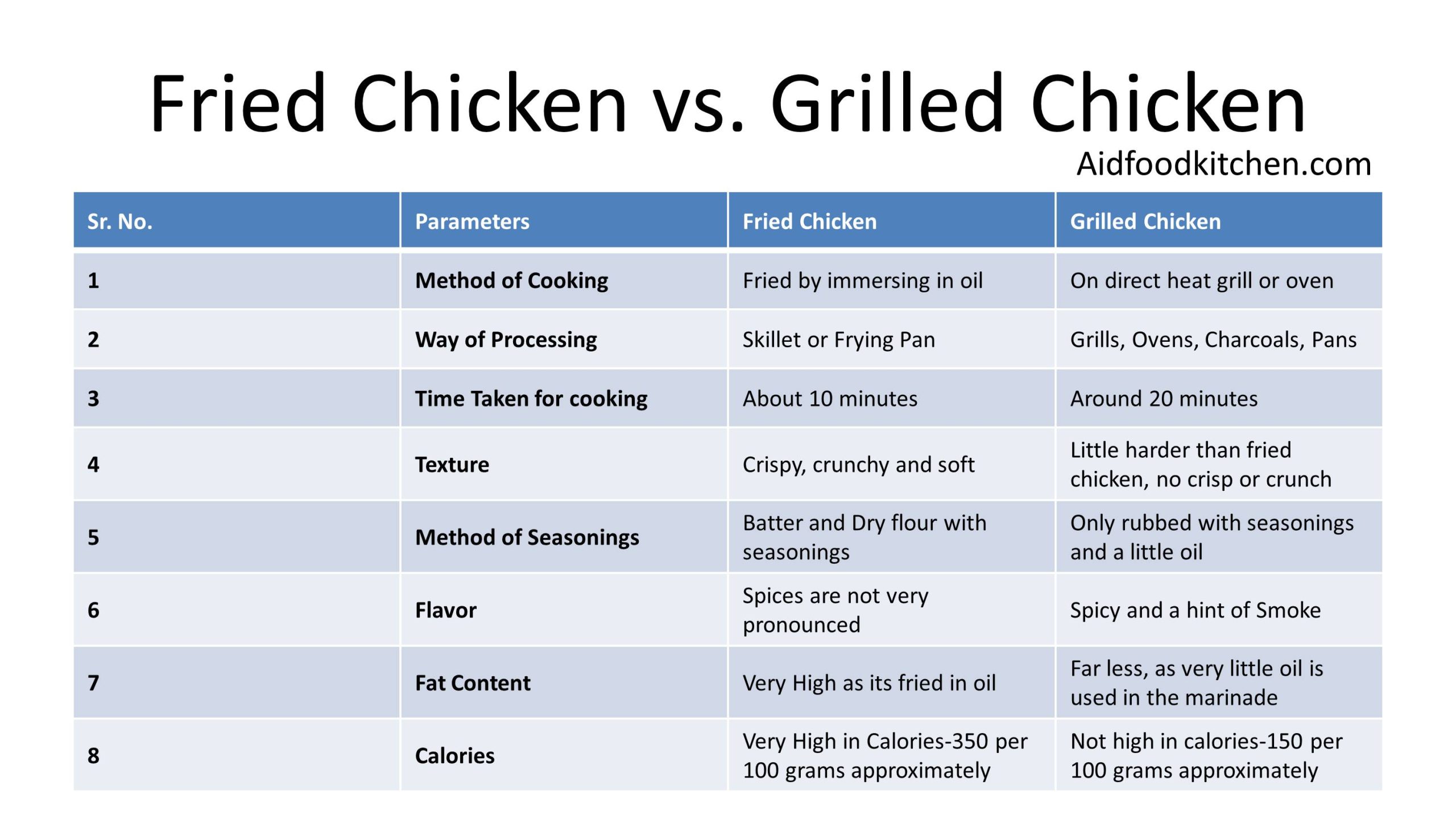The age-old debate rages on. When it comes to chicken, do you prefer it fried or grilled? Both cooking methods have passionate fans who swear their preferred preparation reigns supreme. Let’s break down the pros and cons of fried and grilled chicken to determine a winner in this flavor showdown.

Fried Chicken
Fried chicken is a popular dish made by coating chicken in a seasoned batter and deep-frying until it is crispy and golden brown. While it can be a delicious treat, fried chicken is also high in calories, fat, and sodium. Here are some nutrition facts about fried chicken:
- A typical serving of fried chicken, which is around 3.5 to 4 ounces, contains about 250 to 350 calories, depending on the cooking method and type of chicken used.
- Fried chicken is high in fat, with a typical serving containing around 20 to 25 grams, depending on the recipe and cooking method. Unfortunately, much of this fat is saturated, contributing to high cholesterol levels and increasing the risk of heart disease.
- Fried chicken is also high in sodium, with a typical serving containing 500 to 600 milligrams or more. Too much sodium can increase blood pressure and the risk of heart disease and stroke.
- Fried chicken is not a significant source of carbohydrates or fiber. Still, it does contain some protein, with a typical serving containing around 25 to 30 grams of protein, depending on the recipe and cooking method.
- When consumed in moderation and as part of a balanced diet, fried chicken can be enjoyed as an occasional treat. However, it is essential to be mindful of portion sizes and choose healthier cooking methods, such as baking or grilling, to reduce the calorie and fat content. Adding a side of vegetables or a salad can also help increase the meal’s nutritional value.
Grilled Chicken
Grilled chicken is a healthy and nutritious protein source that is low in fat and calories. It is a versatile ingredient that can be enjoyed independently, as part of a salad, or in a sandwich. Here are some nutrition facts about grilled chicken:
- A typical serving of grilled chicken, around 3.5 to 4 ounces, contains about 120 to 150 calories, depending on the cut and preparation method.
- Grilled chicken is low in fat, with a typical serving containing around 2 to 5 grams, depending on the cut and preparation method. Much of the fat in chicken is unsaturated fat, which can benefit heart health when consumed in moderation.
- Grilled chicken is also a good source of protein. A typical serving contains 25 to 30 grams of protein, depending on the cut and preparation method. Protein is essential for building and repairing tissues and maintaining muscle mass and strength.
- Grilled chicken is not a significant source of carbohydrates or fiber, but it does contain some vitamins and minerals, such as vitamin B6, vitamin B12, and iron.
- Grilled chicken can be a part of a healthy and balanced diet when prepared with wholesome ingredients and served with nutritious sides such as vegetables or whole grains. However, it is essential to be mindful of portion sizes and avoid overconsumption of sauces or marinades that may be high in sugar or sodium.
Fried Chicken vs. Grilled Chicken Calories
Grilled chicken (5 ounces of meat) has 232 calories, while fried chicken (5 ounces) has 383 calories. Therefore, fried chicken has approximately 65.1% more calories than grilled chicken.

The battle of the birds: fried chicken versus grilled chicken. Both are delicious and popular options, but one reigns supreme regarding nutrition and calories.
According to the USDA, a 5-ounce serving of grilled chicken breast contains 232 calories. The same serving size of fried chicken contains 383 calories – 65.1% more calories!
Why such a significant difference? The cooking method is the culprit. Deep frying chicken adds many extra calories because it soaks up the oil it’s cooked in. It retains much oil even if you drain the fried chicken on paper towels. All those extra calories from cooking oil add up quickly.
Grilling chicken does not require cooking oil, so it’s a much leaner cooking method. In addition, the grilled chicken breast has fewer calories and less fat (only 3.6 grams compared to fried chicken’s 19.2 grams). So it’s a much healthier choice if calories and fat are a concern.
However, fried chicken has some advantages, too. Many people find it more flavorful and enjoyable thanks to the crispy, golden-brown crust and seasoning on the outside of the chicken. Fried chicken is also a popular comfort food for many and can be part of a balanced diet in moderation. As with most foods, fried chicken is acceptable as an occasional treat, but grilled chicken is the way to go for everyday meals if you’re watching your calorie and fat intake.
The next time you crave chicken, consider firing up the grill or oven instead of the deep fryer.
Fried Chicken vs. Grilled Chicken
Fried Chicken:
- Typically, it contains around 250 to 350 calories per serving, depending on the recipe and cooking method.
- High in fat, with a typical serving containing around 20 to 25 grams of fat, much of which is saturated fat.
- High in sodium, with a typical serving containing around 500 to 600 milligrams of sodium or more.
- It is not a significant source of carbohydrates or fiber, but it contains some protein.
- It tends to be crispy and flavorful due to the batter and deep-frying method.
Grilled Chicken:
- Typically, it contains around 120 to 150 calories per serving, depending on the cut and preparation method.
- It is low in fat, with a typical serving containing around 2 to 5 grams of fat, much of which is unsaturated.
- It is lower in sodium than fried chicken, with a typical serving containing 100 to 200 milligrams of sodium or less.
- It is a good source of protein, with a typical serving containing 25 to 30 grams.
- It tends to be tender and juicy with a smoky flavor due to the grilling method.
Grilled chicken is generally considered healthier than fried chicken due to its lower calorie, fat, and sodium content. Here are some reasons why grilled chicken is a healthier choice than fried chicken:
- Lower in calories: Grilled chicken is generally lower than fried chicken, as it does not absorb as much oil or fat during cooking. This can help you maintain a healthy weight and reduce the risk of obesity-related health conditions.
- Lower in fat: Grilled chicken is lower in fat than fried chicken, as it is not battered or breaded and does not require oil for cooking. This can help to reduce your intake of saturated and trans fats, which can increase your risk of heart disease, high cholesterol, and other health problems.
- Lower in Sodium: Grilled chicken is typically lower in sodium than fried chicken, as it does not require the addition of salt or other high-sodium ingredients. Too much sodium can increase your risk of high blood pressure and heart disease, so choosing lower-sodium options can benefit your health.
- Retaining more nutrients: Grilling chicken helps have more nutrients than frying, as it does not involve high heat or prolonged cooking times that can cause nutrient loss. Grilled chicken is a good source of protein, vitamins, and minerals to support your overall health and well-being.
- Delicious and versatile: Grilled chicken is a tasty and versatile protein source that can be enjoyed in various dishes, from salads and sandwiches to stir-fries and pasta dishes. It can also be seasoned and marinated in many ways to add flavor and variety to your meals.
Grilled chicken is a healthier option than fried chicken due to its lower calorie, fat, and sodium content and ability to retain more nutrients during cooking. In addition, choosing grilled chicken as a protein source allows you to enjoy a delicious and nutritious meal that supports your overall health and well-being.
Grilled chicken is a healthier option than fried chicken due to its lower calorie, fat, and sodium content. Grilling also tends to preserve more of the chicken’s nutrients and natural flavor, making it a nutritious and delicious choice for any meal.
- How Many Tablespoons is One Clove of Garlic? - June 26, 2024
- How to Measure 3/4 Cup When You Don’t Have the Right Measuring Cup? - June 6, 2024
- How Much Does Cooked Pasta Weight Compare To Dry? - April 30, 2024
